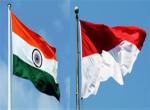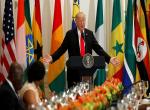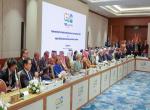While China had announced the year 2015 as ‘Visit India’ year after the visit of President Xi Jinping to India last September, this year after the visit of Prime Minister Modi to China officials in Beijing are in an overdrive to implement some of the agreements announced during the two summits. Strengthening economic and cultural relations while bypassing the strategic differences has been the dominant narrative of Chinese think tanks and government officials. Public diplomacy aimed at both internal and external audience in order to achieve policy objectives are the other leitmotifs of the current discourse. Thus as part of its public diplomacy exercise, China’s Ministry of Foreign Affairs invited a group of strategic experts and media personnel from India to showcase the extent of their economic development and how ‘One Belt, One Road’ strategy of connectivity can be mutually beneficial while the strategic dissonance could be put on the backburner in the meanwhile.
The visit, spread over a period of more than one week was structured to include briefings from the government officials, a seminar on strategic, economic, cultural and media issues followed by visits to China’s industrial and business establishments that have been in the forefront of China’s fast paced economic growth and development. Visits to Shenzhen Special Economic Zone and Guangzhou, both part of Guangdong which is one of the wealthiest provinces of China were designed to acquaint the Indian delegation with the quality and nature of progress achieved in diverse areas of human endeavour. Promoting bilateral economic and cultural cooperation was the underlying theme during the entire period of the visit.
MoFA Briefing: Of LAC and Beyond
Mr. Huang Xilian, Deputy Director General for Asian affairs (among other things, he deals with India) of China’s Foreign Ministry briefed the delegation about Prime Minister Modi’s visit to China and his resultant popularity especially amongst the Chinese youth particularly after opening of his microblog account on Weibo, China’s popular social media network. The grand reception accorded to Prime Minister Modi at Xian by President Xi Jinping was a unique and special gesture to him. Mr Modi’s Speech at Tsinghua University was well received by the students. He dwelt on the positive aspects of emerging Sino-Indian relationship that places more emphasis on economic, cultural and people to people relations. Huang said that both leaders have a vision to work together towards an Asian Century. The differences should be handled in a constructive way, however, that is a story which we have been hearing for a long time.
When questioned about China’s stand on Mr Modi’s suggestion on clarification of LAC and resolving of border issue, the Chinese official attempted to sideline the issue by saying that he is not expert on the border problem. However, he pointed out that both leaders had agreed to seek an early resolution; but this should not affect the other relationship as also both sides had agreed to maintain peace and tranquillity along the border.
Pressed again by the visiting delegation on the need for clarification of LAC being an essential element of Confidence Building Measures, Huang revealed that ‘we tried to clarify (LAC) sometime back but the issue became complex’. He was referring to the process of clarification of LAC that was discontinued after 2005. On the other hand, establishing a ‘Code of Conduct’ is the new formulation which is being advanced by Chinese interlocutors for some time now. And that is what Huang reiterated though how this new proposal would be of any help when any number of such agreements (like Border Defence Cooperation Agreement--BDCA) of 2013, Political Parameters and Guiding Principles for the Settlement of India-China Boundary question of 2005, Agreement on Confidence Building Measures in the Military Field along the LAC in the India-China Border Areas of 1996 and Agreement on the Maintenance of Peace and Tranquility along the LAC in the India-China Border Areas of 1993) have not advanced the cause of either clarification of LAC or settlement of the dispute was left unexplained.
Dwelling further on the issue Huang Xilian observed that whatever we do in the border area, it should be constructive; meaning that it should be a building block to the process of negotiations and not a stumbling block. “If we find that the clarification of the LAC is a building block, then of course we should go ahead. But if we find that it could become a stumbling block, it could complicate further the situation, then, we have to be careful.”
During the briefing Beijing based representatives of Indian media were also present. One of the prominent Indian newspapers went to town next day with a headline that China had rejected PM Modi’s proposal for clarification of LAC made during his address at Tsinghua University on May 15. This did cause a flutter in the South Block for a while but after checking with Indian ambassador at Beijing and other Indian correspondents it was concluded that newspaper report was somewhat of a hyperbole. Huang’s statement was much more nuanced in that though it did not reject resuming the process of LAC clarification yet one could sense that China was reluctant to start the process despite PM Modi’s suggestion that ‘We can do this without prejudice to our position on the boundary question’.
Symposium on China-India Relations
As part of the ongoing visit a conference was organized under the aegis of China Public Diplomacy Association (a think tank under the MoFA) to discuss Sino-Indian relations in the aftermath of PM Modi’s visit to China. Main themes of the seminar were regional peace and stability, economic growth, interactions between media of both sides and new ideas for boosting bilateral cooperation on international affairs. On strategic and economic issues both sides reiterated their usual positions; Zhou Gang a former ambassador of China to India and a frequent participant of such interactions emphasized on both sides taking a long term perspective while another Chinese speaker underscored the need for easing India’s visa norms for Chinese visitors who were bracketed with citizens of countries like Afghanistan, Pakistan, Sudan etc. Indian side brought out the need for resolution of boundary question pending which clarification of LAC would act as a great CBM. Question of China’s selective approach to terrorism and its proclivity to look at it through Pakistani prism was underlined. Especially, China’s reluctance to endorse India’s request to list Hizbul Mujahideen chief and head of the ‘United Jihad Council’, Syed Salahuddin to be placed in the list of the United Nations Security Council sanctions committee on Al-Qaida and associated entities was mentioned by the Indian delegation. However, the response of Chinese side was that Pakistan is a complicated country; it has lost more in fight against terrorism and the usual disclaimer that they had not followed this particular case while maintaining that they did not believe in double standards on terrorism.
It needs to be noted that the joint statement between Prime Minister Modi and Chinese Premier Li Keqiang of May 15 states their commitment to fighting terror and “urged all countries and entities to work sincerely to disrupt terrorist networks and their financing, and stop cross-border movement of terrorists”.
However, of particular note were key points that emerged out of interaction between the media reps of both sides. Interestingly, Executive Editor of Global Times also made a presentation besides a professor from School of Journalism and Communication from Tsinghua University. Prof. Zhou Qing’an that Chinese media devoted more time and space to issues with Japan; India was covered much less compared to Japan. There was general consensus that media from both sides tended to exaggerate the divergences rather than the convergences. There was need to do balanced, constructive and positive stories. Though Chinese media seems to be monolithic and controlled by government yet different papers for example the Global Times (this point was brought out by Prof. Zhou) do not represent government views and possibly that is why it was most profitable paper. Even in India while media will give out government views largely on international affairs it was more inclined to stress on the negative aspects and differences.
Another point of import was that both media view each other from a western prism due to domination of the narrative by the West. There was a need to develop mutual understanding through own languages as also through more people to people exchanges. There were a limited number of journalists from both sides in each other’s countries and their presence was largely capitals-centric. There was a requirement of going out to provinces, towns and rural areas to get the real flavour of a country. Further, there was need to train media professionals who have a domain knowledge or special understanding of the political, economic, social issues and of many other aspects that help strengthening of the overall bilateral relationship.
China’s Development and Reforms
Next stop of the delegation was a visit to China’s National Development and Reforms Commission (NDRC), China Railway and China Radio International. NDRC is China’s top body that formulates policies for economic and social development, maintain the balance of economic development, and guides restructuring of China's economic system. In March NDRC had issued a White Paper titled “Vision and Actions on Jointly Building Silk Road Economic Belt and 21st- Century Maritime Silk Road”. In fact, it is somewhat equivalent of our NITI Ayog; the next meeting of the Strategic Economic Dialogue, co-chaired by Vice Chairman of NITI Aayog of India and Chairman of NDRC of China has been planned in India during the second half of 2015.
Briefing and interaction at NDRC largely revolved around explanation of the above paper and the concept of ‘One Belt One Road’ (OBOR). Mr. Zhao Chenxin outlined the background of OBOR and highlighted its salient features that among other things included improved connectivity and infrastructure, greater trade and economic activity, enhanced cooperation in industrial investment, development of resources of energy, financial cooperation, people to people exchanges, environmental cooperation and cooperation in maritime affairs. He was of the view that there were complementarities in Chinese and Indian economies and potential existed for further progress on economic cooperation.
When questioned on China’s expectations from India on Maritime Silk Road proposal he pointed out that mutual benefit was the principle. India is an important country at the junctions of Silk Road, there was vast potential for cooperation. He suggested aligning India’s Look East Policy and OBOR for mutual benefit. Expressing unfamiliarity with India’s Mausam project based on the ancient spice route he did agree that complementarities exist between the two projects. As to how many countries had joined the OBOR he observed it was difficult to give an accurate number but 60 to 70 countries have expressed interest. Gradually, the number of nations willing to join has been on the upward trajectory; if it brings benefits to them then the number might grow to even 90 but if there are no benefits the number may go down to 30. On being asked to outline mechanisms or process for joining OBOR and whether it will be on bilateral or multilateral basis he observed that OBOR needs to explore both approaches i.e. both one that is a duet and the other that is a group song. Already there were six economic corridors planned that reflected both bilateral and multilateral approaches. Chinese government is planning to hold a high level summit next year on OBOR to take the concept forward. Objective was to unleash growth potential and it will certainly help recovery of the world economy. He was at pains to suggest that OBOR was an important strategic decision in terms of economy and not in terms of geopolitics.
Showcasing the High Speed Railway
The progress achieved by China in high speed rail technology was explained to the visiting delegation by Mr. Zhao Guotang, Vice Chief Engineer of China Railway. He went into different stages of development of the High Speed Rail (HSR) network and how it has been expanded over the years while ensuring safety and high standards of maintenance and repair. Technologies from Japan, Germany and France were absorbed and indigenous technologies developed to further improve the running of HSR. Traffic volume from Beijing to Shanghai in last three years was 275 million; last year alone it was over 100 million people.
The new technologies have helped reducing the construction time to a very short period; comprehensive costs have also gone down. Monitoring of the entire network can be done from control in the HQ. HSR has over one million staff for 16000 kms of network which is planned to be expanded to 20,00 kms by end of the 13th Five Year Plan programme i.e. by 2020. In fact, by end of 2015 China would complete 18000 km of HSR network and in another year it is likely to cross 19,000 km of length.
On the question of Sino-Indian cooperation in HSR and whether India should go in for upgradation of rail lines for improving speed or straight away go for bullet train he observed that basic conditions in China and India are similar. China’s railways went through six rounds of upgradations and also faced this question. For Indian railways we need to learn from mutual experiences. As is well known India has been looking for Chinese investment in rail infrastructure and the possibility of high speed corridor from Delhi to Chennai. A feasibility study on increasing speed on the existing Chennai-Bengaluru-Mysore line is in progress. Delhi-Nagpur HSR link proposal is also being studied; the station redevelopment planning for Bhubaneswar & Baiyappanahalli, heavy haul transportation training and setting up of a railway university are other areas of cooperation. Options exist to go in for say, shorter high-speed rail links from Chennai to Bangalore and from Delhi to Agra and the possibilities of expansion to the entire length of Delhi-Chennai route. During PM Modi’s visits the two sides had expressed satisfaction with the steps taken and the progress achieved so far in this key infrastructure sector.
In Zhao Guotang’s opinion China’s technology also belonged to the world and technology standards have been formulated in consultation with advanced countries. Presently, the maximum speed of the train is 321 kmph though it is possible for it to be run at 400 kmph.
And finally, China Railway was ready to help India in rail infrastructure on the principle of win-win cooperation. During the preliminary stage of the proposed rail projects in India, Chinese technical staff will carry out a study, during construction stage China would also establish facility for training and educating Indian staff. Those who pass the test can be inducted for filling the required slots for running of the project. Management staff needs to be experienced because of the demands of the nature of the project.
China Radio International (CRI)
The visit to CRI was largely designed to acquaint the delegation with what it is doing to promote Sino-Indian relations besides its other activities aimed at the international audience. An integrated media group it has six modes of broadcast to include radio, internet, TV, mobile, social media and print media. Among South Asian languages it broadcasts in Hindi, Bengali, Tamil, Urdu and Sinhalese; overall it has programmes in 65 languages for the foreign audience. CRI covers whole of India. Its Hindi service receives about 200,000 letters per year; it also broadcasts Tamil and different types of Indian and international music. As part of promoting Sino-Indian relations that are based on civilizational and cultural issues it interviews experts, broadcasts the positive aspects of bilateral relationship and does not stress on the differences. While social media might be becoming more important radio and allied media still had relevance and can be used set positive agenda. In CRI’s view social media cannot be as objective as traditional media which of course is largely true having seen the nature of social media scene in India.
The proposal for bilateral media cooperation, possibly based on the MOU already signed between CCTV and Doordarshan through exchange of TV programmes, training of production and technical staff are some the ideas that came up and need to be pursued further.
In conclusion it can be said that there is no reason as to why India should not pursue a stronger economic relationship with China after going through a due diligence exercise. If nations like US and Japan can maintain robust economic relationship with China despite competitive politics then India could also learn from their experience. While geopolitics would continue to be present in any kind of bilateral relationship it will be a test of diplomatic and leadership skills to make geo-economics as the dominant factor of the Sino-Indian ties.
(Part II of the report will cover visit to technical and industrial establishments of Shenzhen and Guangzhou as also briefing by government officials)
Published Date: 22nd June 2015
(Disclaimer: The views and opinions expressed in this article are those of the author and do not necessarily reflect the official policy or position of the Vivekananda International Foundation)










Post new comment